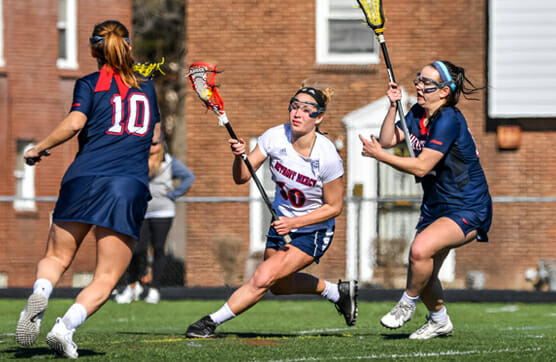Training the female athlete: nutritional considerations

Training the female athlete: nutritional considerations
By Aloiya Earl, MD and Drew Coker, MS, CSCS, RD
The Ohio State University Wexner Medical Center; Spartan Performance @ Michigan State University
Coaching the adolescent and high school female athlete involves being mindful of the unique requirements of this population. Beyond the importance of a well-designed strength and conditioning program to improve general fitness and decrease the likelihood of injury, it is equally important that coaches address healthy eating and nutrition in the female athlete.
Poor nutritional habits in the adolescent female can lead not only to sub-optimal athletic performance but also bone fragility and other health issues. In this blog, we combine our expertise in sports medicine and sports nutrition to outline four important nutritional considerations in the high school-aged female athlete. (Note: It is important to understand that if you have a medical concern related to nutrition about an athlete that you should recommend that the athlete seek appropriate medical attention from a qualified individual such as a certified athletic trainer, physician and/or registered dietitian.)

Are they eating enough?
Energy balance is a component of performance and health that is often overlooked or downplayed in the female athlete but can have long lasting consequences. Female athletes and their coaches both need to be educated on this topic and taught how to apply sound nutrition principles to promote healthy eating practices. With that said, maintaining an adequate caloric intake for the amount of energy expended (energy balance) in this group can be a challenge, and it can potentially demand a purposeful effort from these athletes and their coaches and parents.
Many athletic teenage females do not intentionally under-eat, but are often still energy deficient (consume less calories then overall energy needs). Exact caloric demands depend on age, height, weight, and activity level, but many high school athletes need upwards of 2,500+ calories per day. That’s a lot of food for a high school girl! especially when it’s mostly healthy food and not calorie-dense junk food.
Keeping a food log and meeting with a physician or dietician can help athletes determine if they’re taking in enough energy to meet their energy needs. There are free or low-cost apps available to track food and estimate calories consumed along with macro-nutrient (carbs, fats, protein) and micro-nutrient (vitamins, minerals) composition of the diet.
Are they having a regular period (or periods at all)?
Having a monthly period (menstruation) is an easy indicator for adequate nutrition in this age group. The average age for starting periods is around age 12, and over 90% of girls have their first period by age 14; however, there is considerable variable in this pubertal event among early, average and late maturers. If high school females are missing periods or not having periods at all, it could mean there’s an imbalance in their ratio of energy in (food) to energy out (exercise). This leads to low estrogen levels which can cause a decrease in bone density and therefore an increased risk for broken bones and stress fractures.
Are they getting enough calcium and vitamin D?
Calcium and vitamin D work together. Calcium is needed to build and maintain healthy bones, and vitamin D is needed to help the body absorb calcium. High school females should have 1,300 mg of calcium per day and 600 IU of vitamin D per day (again, this is something that can be tracked on nutrition apps).
 Ideally, calcium should come from food (leafy green vegetables, oranges, tofu, beans, almonds, dairy if tolerated, fortified cereal) and not supplements. Vitamin D can be found in food (fish, egg yolks, fortified oatmeal) and is also absorbed from sunlight. If there is concern for deficiency from food, vitamins can help. Keep in mind supplements should be viewed as just that: a supplement to a nutrient-rich diet, rather than a replacement to make up for poor eating habits.
Ideally, calcium should come from food (leafy green vegetables, oranges, tofu, beans, almonds, dairy if tolerated, fortified cereal) and not supplements. Vitamin D can be found in food (fish, egg yolks, fortified oatmeal) and is also absorbed from sunlight. If there is concern for deficiency from food, vitamins can help. Keep in mind supplements should be viewed as just that: a supplement to a nutrient-rich diet, rather than a replacement to make up for poor eating habits.
How do they perceive their body?
This component probably overlaps with nutrition and involvement in sports. Coaches should carefully consider a systematic way to help encourage females to look beyond body image and realize their worth is not based on the way they look or the way other people perceive them. Yes, it is important to feel good about yourself and the way that we look is a part of self-confidence but not all of it. This is a touchy subject that needs to be approached skillfully, and is a major part of helping our female athletes develop into healthy independent women.
Summary
 In summary, with consistent efforts to ensure adolescent and high school female athletes are optimizing their health through good nutrition, attention can be turned to training allowing these athletes to safely work towards their performance goals. And, in the end they will have a toolbox of skills related to maintaining and living a healthy lifestyle from a positive experience in sports led and taught by informed and caring coaches.
In summary, with consistent efforts to ensure adolescent and high school female athletes are optimizing their health through good nutrition, attention can be turned to training allowing these athletes to safely work towards their performance goals. And, in the end they will have a toolbox of skills related to maintaining and living a healthy lifestyle from a positive experience in sports led and taught by informed and caring coaches.
Related Perform-X blogs
3 things every high school coach should know about training the female athlete